Indigenous Education and Perspectives: History of Australia Essay
VerifiedAdded on 2020/03/02
|9
|2121
|55
Essay
AI Summary
This essay delves into the complexities of Indigenous education and perspectives on Australian history, examining contrasting viewpoints on how history should be taught, particularly the use of language and the inclusion of Indigenous perspectives. It analyzes the impact of media representation on Aboriginal and Torres Strait Islander communities, highlighting how stereotypical portrayals affect self-esteem and cultural identity. The essay further explores the challenges in constructing Indigenous and non-Indigenous cultural identities in Australia, emphasizing the role of media and education in perpetuating or challenging harmful stereotypes. It argues for the adoption of inclusive teaching methods, the importance of teacher training, and the need for media to accurately portray Indigenous cultures to foster mutual respect and reconciliation. The essay concludes by emphasizing the critical role of education and media in promoting a balanced view of Indigenous and non-Indigenous values, thus contributing to the creation of a cohesive and multicultural society in Australia.
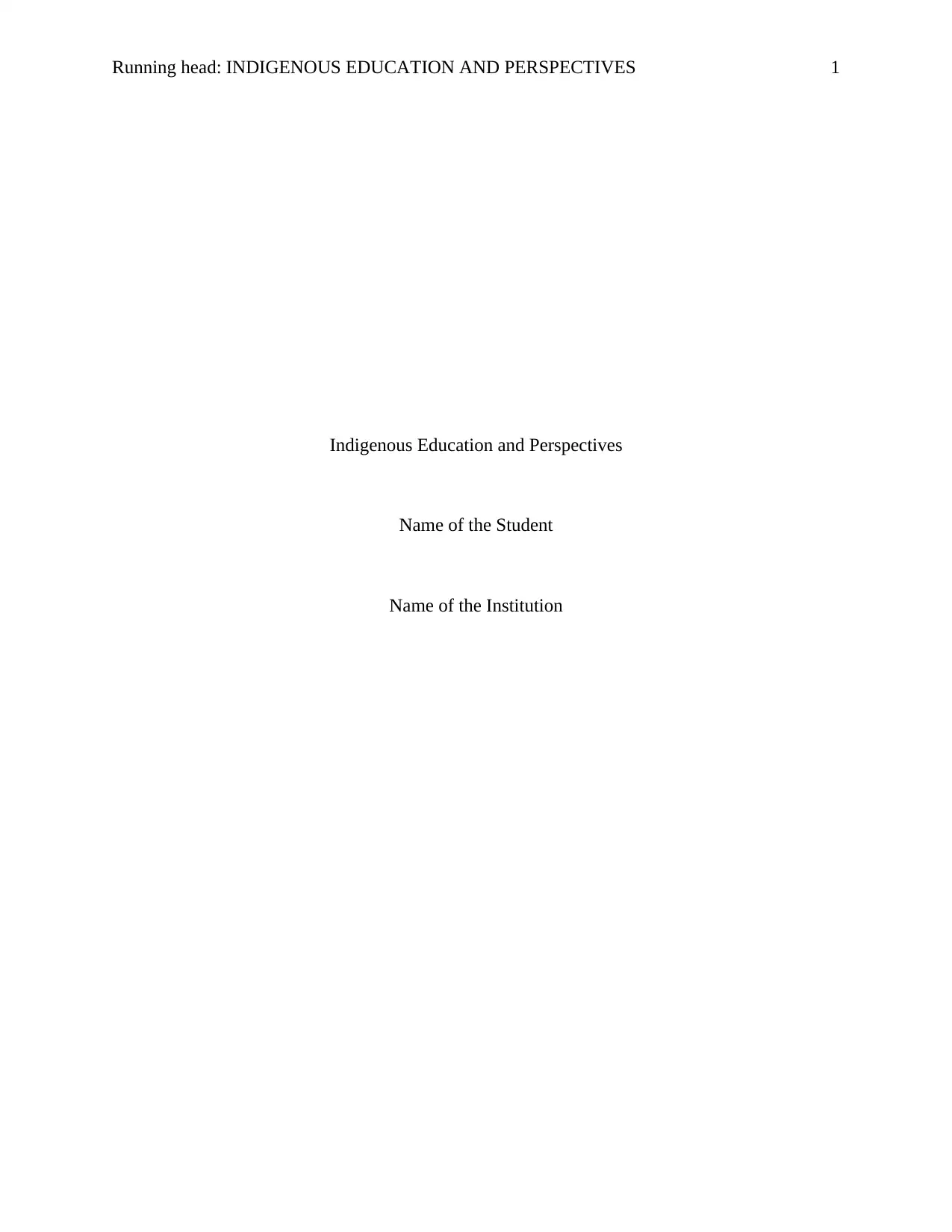
Running head: INDIGENOUS EDUCATION AND PERSPECTIVES 1
Indigenous Education and Perspectives
Name of the Student
Name of the Institution
Indigenous Education and Perspectives
Name of the Student
Name of the Institution
Paraphrase This Document
Need a fresh take? Get an instant paraphrase of this document with our AI Paraphraser
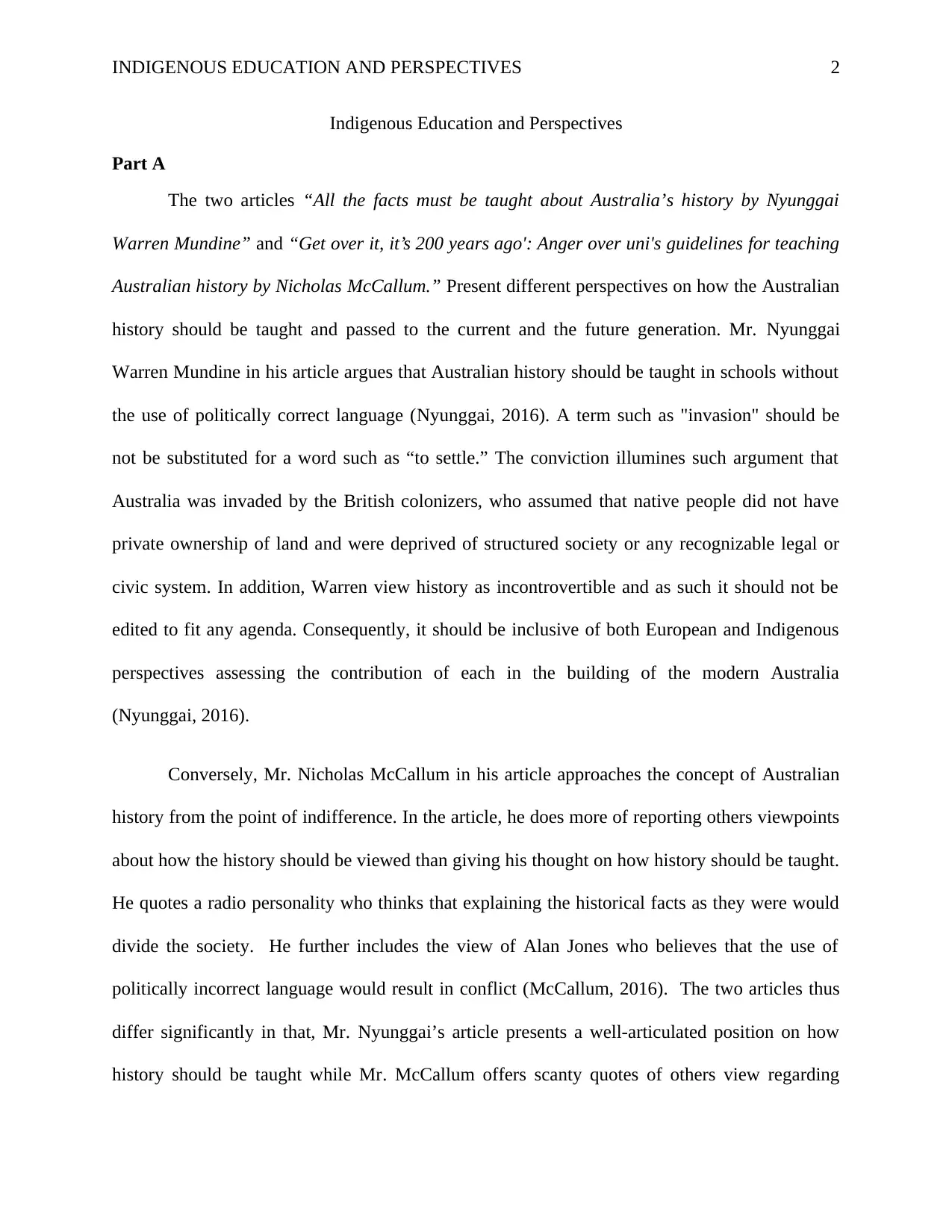
INDIGENOUS EDUCATION AND PERSPECTIVES 2
Indigenous Education and Perspectives
Part A
The two articles “All the facts must be taught about Australia’s history by Nyunggai
Warren Mundine” and “Get over it, it’s 200 years ago': Anger over uni's guidelines for teaching
Australian history by Nicholas McCallum.” Present different perspectives on how the Australian
history should be taught and passed to the current and the future generation. Mr. Nyunggai
Warren Mundine in his article argues that Australian history should be taught in schools without
the use of politically correct language (Nyunggai, 2016). A term such as "invasion" should be
not be substituted for a word such as “to settle.” The conviction illumines such argument that
Australia was invaded by the British colonizers, who assumed that native people did not have
private ownership of land and were deprived of structured society or any recognizable legal or
civic system. In addition, Warren view history as incontrovertible and as such it should not be
edited to fit any agenda. Consequently, it should be inclusive of both European and Indigenous
perspectives assessing the contribution of each in the building of the modern Australia
(Nyunggai, 2016).
Conversely, Mr. Nicholas McCallum in his article approaches the concept of Australian
history from the point of indifference. In the article, he does more of reporting others viewpoints
about how the history should be viewed than giving his thought on how history should be taught.
He quotes a radio personality who thinks that explaining the historical facts as they were would
divide the society. He further includes the view of Alan Jones who believes that the use of
politically incorrect language would result in conflict (McCallum, 2016). The two articles thus
differ significantly in that, Mr. Nyunggai’s article presents a well-articulated position on how
history should be taught while Mr. McCallum offers scanty quotes of others view regarding
Indigenous Education and Perspectives
Part A
The two articles “All the facts must be taught about Australia’s history by Nyunggai
Warren Mundine” and “Get over it, it’s 200 years ago': Anger over uni's guidelines for teaching
Australian history by Nicholas McCallum.” Present different perspectives on how the Australian
history should be taught and passed to the current and the future generation. Mr. Nyunggai
Warren Mundine in his article argues that Australian history should be taught in schools without
the use of politically correct language (Nyunggai, 2016). A term such as "invasion" should be
not be substituted for a word such as “to settle.” The conviction illumines such argument that
Australia was invaded by the British colonizers, who assumed that native people did not have
private ownership of land and were deprived of structured society or any recognizable legal or
civic system. In addition, Warren view history as incontrovertible and as such it should not be
edited to fit any agenda. Consequently, it should be inclusive of both European and Indigenous
perspectives assessing the contribution of each in the building of the modern Australia
(Nyunggai, 2016).
Conversely, Mr. Nicholas McCallum in his article approaches the concept of Australian
history from the point of indifference. In the article, he does more of reporting others viewpoints
about how the history should be viewed than giving his thought on how history should be taught.
He quotes a radio personality who thinks that explaining the historical facts as they were would
divide the society. He further includes the view of Alan Jones who believes that the use of
politically incorrect language would result in conflict (McCallum, 2016). The two articles thus
differ significantly in that, Mr. Nyunggai’s article presents a well-articulated position on how
history should be taught while Mr. McCallum offers scanty quotes of others view regarding
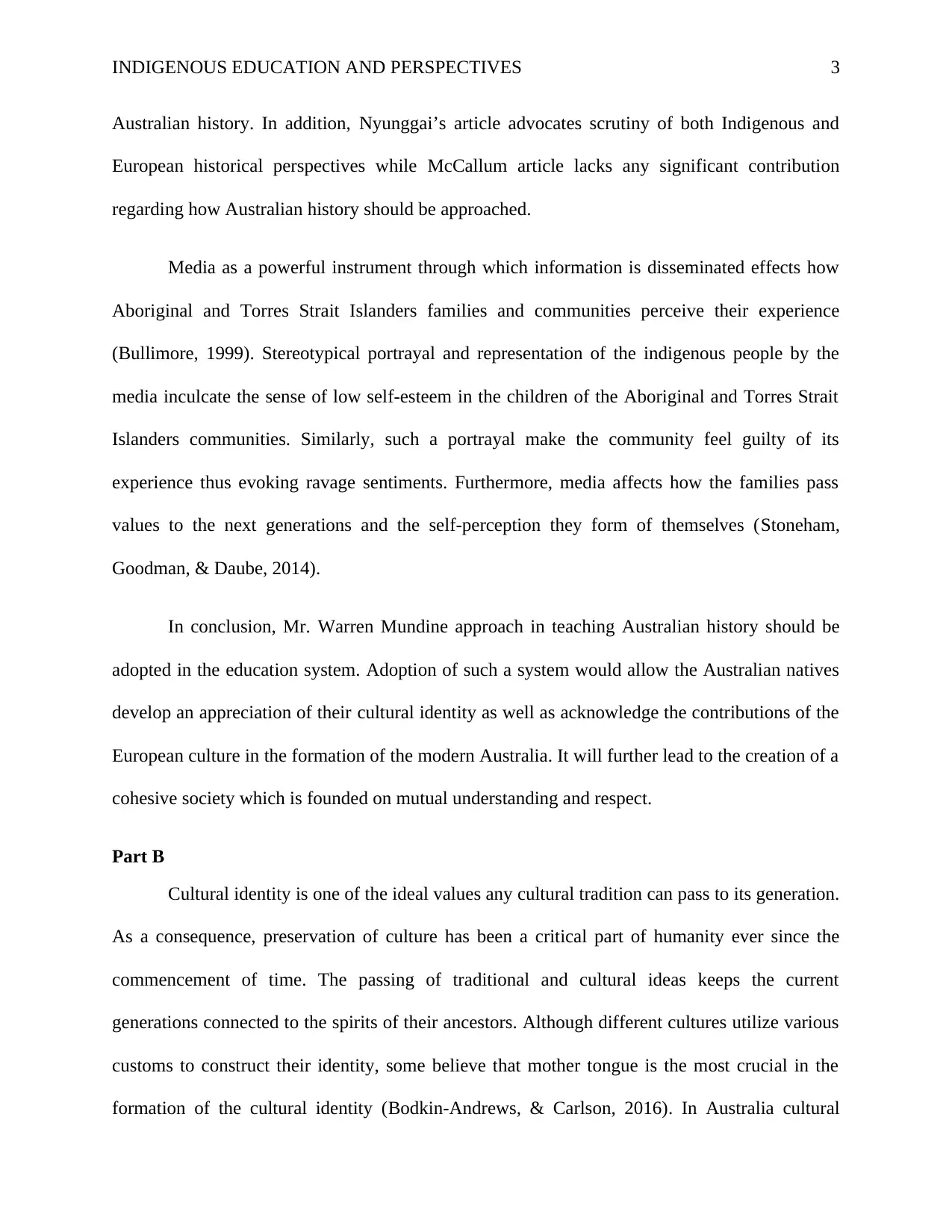
INDIGENOUS EDUCATION AND PERSPECTIVES 3
Australian history. In addition, Nyunggai’s article advocates scrutiny of both Indigenous and
European historical perspectives while McCallum article lacks any significant contribution
regarding how Australian history should be approached.
Media as a powerful instrument through which information is disseminated effects how
Aboriginal and Torres Strait Islanders families and communities perceive their experience
(Bullimore, 1999). Stereotypical portrayal and representation of the indigenous people by the
media inculcate the sense of low self-esteem in the children of the Aboriginal and Torres Strait
Islanders communities. Similarly, such a portrayal make the community feel guilty of its
experience thus evoking ravage sentiments. Furthermore, media affects how the families pass
values to the next generations and the self-perception they form of themselves (Stoneham,
Goodman, & Daube, 2014).
In conclusion, Mr. Warren Mundine approach in teaching Australian history should be
adopted in the education system. Adoption of such a system would allow the Australian natives
develop an appreciation of their cultural identity as well as acknowledge the contributions of the
European culture in the formation of the modern Australia. It will further lead to the creation of a
cohesive society which is founded on mutual understanding and respect.
Part B
Cultural identity is one of the ideal values any cultural tradition can pass to its generation.
As a consequence, preservation of culture has been a critical part of humanity ever since the
commencement of time. The passing of traditional and cultural ideas keeps the current
generations connected to the spirits of their ancestors. Although different cultures utilize various
customs to construct their identity, some believe that mother tongue is the most crucial in the
formation of the cultural identity (Bodkin-Andrews, & Carlson, 2016). In Australia cultural
Australian history. In addition, Nyunggai’s article advocates scrutiny of both Indigenous and
European historical perspectives while McCallum article lacks any significant contribution
regarding how Australian history should be approached.
Media as a powerful instrument through which information is disseminated effects how
Aboriginal and Torres Strait Islanders families and communities perceive their experience
(Bullimore, 1999). Stereotypical portrayal and representation of the indigenous people by the
media inculcate the sense of low self-esteem in the children of the Aboriginal and Torres Strait
Islanders communities. Similarly, such a portrayal make the community feel guilty of its
experience thus evoking ravage sentiments. Furthermore, media affects how the families pass
values to the next generations and the self-perception they form of themselves (Stoneham,
Goodman, & Daube, 2014).
In conclusion, Mr. Warren Mundine approach in teaching Australian history should be
adopted in the education system. Adoption of such a system would allow the Australian natives
develop an appreciation of their cultural identity as well as acknowledge the contributions of the
European culture in the formation of the modern Australia. It will further lead to the creation of a
cohesive society which is founded on mutual understanding and respect.
Part B
Cultural identity is one of the ideal values any cultural tradition can pass to its generation.
As a consequence, preservation of culture has been a critical part of humanity ever since the
commencement of time. The passing of traditional and cultural ideas keeps the current
generations connected to the spirits of their ancestors. Although different cultures utilize various
customs to construct their identity, some believe that mother tongue is the most crucial in the
formation of the cultural identity (Bodkin-Andrews, & Carlson, 2016). In Australia cultural
⊘ This is a preview!⊘
Do you want full access?
Subscribe today to unlock all pages.

Trusted by 1+ million students worldwide
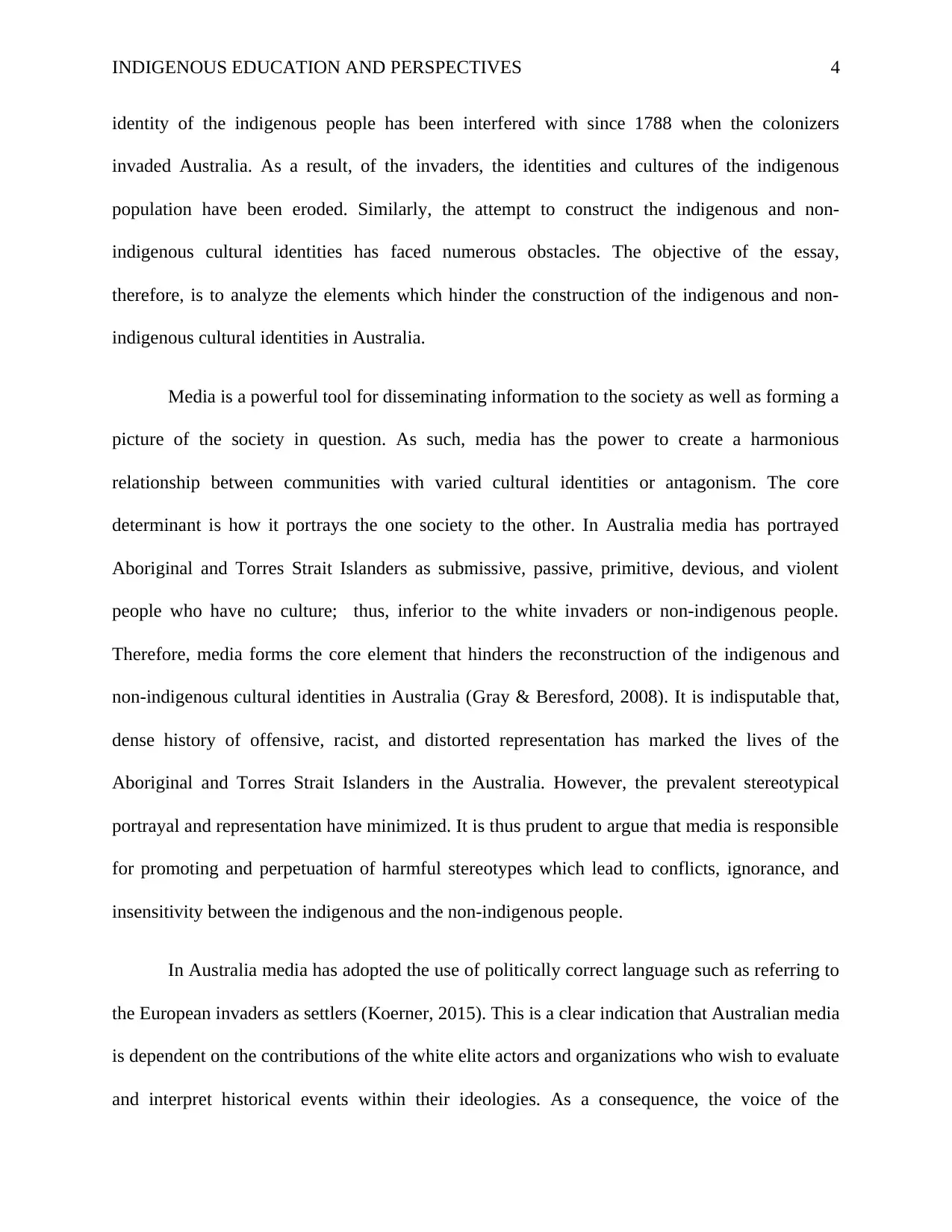
INDIGENOUS EDUCATION AND PERSPECTIVES 4
identity of the indigenous people has been interfered with since 1788 when the colonizers
invaded Australia. As a result, of the invaders, the identities and cultures of the indigenous
population have been eroded. Similarly, the attempt to construct the indigenous and non-
indigenous cultural identities has faced numerous obstacles. The objective of the essay,
therefore, is to analyze the elements which hinder the construction of the indigenous and non-
indigenous cultural identities in Australia.
Media is a powerful tool for disseminating information to the society as well as forming a
picture of the society in question. As such, media has the power to create a harmonious
relationship between communities with varied cultural identities or antagonism. The core
determinant is how it portrays the one society to the other. In Australia media has portrayed
Aboriginal and Torres Strait Islanders as submissive, passive, primitive, devious, and violent
people who have no culture; thus, inferior to the white invaders or non-indigenous people.
Therefore, media forms the core element that hinders the reconstruction of the indigenous and
non-indigenous cultural identities in Australia (Gray & Beresford, 2008). It is indisputable that,
dense history of offensive, racist, and distorted representation has marked the lives of the
Aboriginal and Torres Strait Islanders in the Australia. However, the prevalent stereotypical
portrayal and representation have minimized. It is thus prudent to argue that media is responsible
for promoting and perpetuation of harmful stereotypes which lead to conflicts, ignorance, and
insensitivity between the indigenous and the non-indigenous people.
In Australia media has adopted the use of politically correct language such as referring to
the European invaders as settlers (Koerner, 2015). This is a clear indication that Australian media
is dependent on the contributions of the white elite actors and organizations who wish to evaluate
and interpret historical events within their ideologies. As a consequence, the voice of the
identity of the indigenous people has been interfered with since 1788 when the colonizers
invaded Australia. As a result, of the invaders, the identities and cultures of the indigenous
population have been eroded. Similarly, the attempt to construct the indigenous and non-
indigenous cultural identities has faced numerous obstacles. The objective of the essay,
therefore, is to analyze the elements which hinder the construction of the indigenous and non-
indigenous cultural identities in Australia.
Media is a powerful tool for disseminating information to the society as well as forming a
picture of the society in question. As such, media has the power to create a harmonious
relationship between communities with varied cultural identities or antagonism. The core
determinant is how it portrays the one society to the other. In Australia media has portrayed
Aboriginal and Torres Strait Islanders as submissive, passive, primitive, devious, and violent
people who have no culture; thus, inferior to the white invaders or non-indigenous people.
Therefore, media forms the core element that hinders the reconstruction of the indigenous and
non-indigenous cultural identities in Australia (Gray & Beresford, 2008). It is indisputable that,
dense history of offensive, racist, and distorted representation has marked the lives of the
Aboriginal and Torres Strait Islanders in the Australia. However, the prevalent stereotypical
portrayal and representation have minimized. It is thus prudent to argue that media is responsible
for promoting and perpetuation of harmful stereotypes which lead to conflicts, ignorance, and
insensitivity between the indigenous and the non-indigenous people.
In Australia media has adopted the use of politically correct language such as referring to
the European invaders as settlers (Koerner, 2015). This is a clear indication that Australian media
is dependent on the contributions of the white elite actors and organizations who wish to evaluate
and interpret historical events within their ideologies. As a consequence, the voice of the
Paraphrase This Document
Need a fresh take? Get an instant paraphrase of this document with our AI Paraphraser
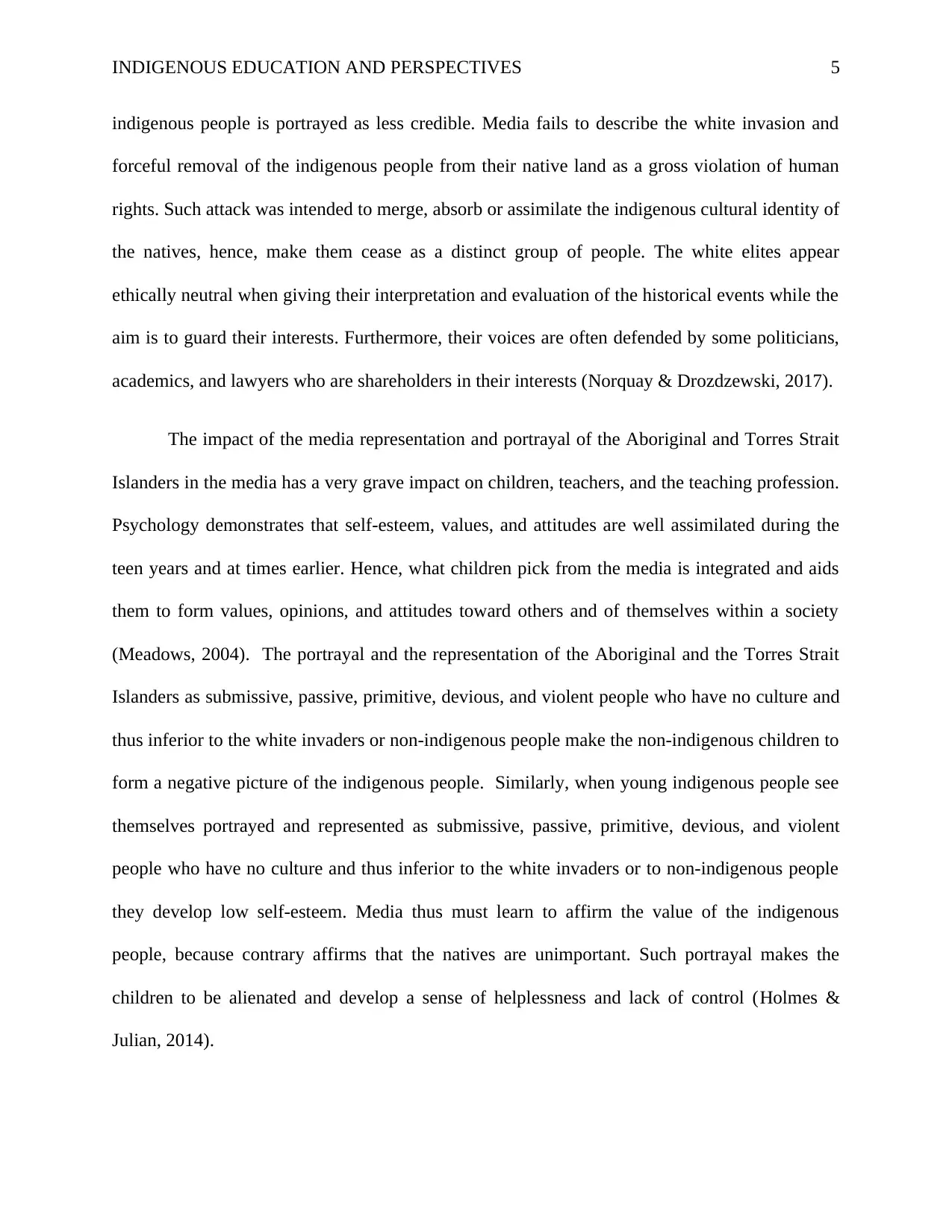
INDIGENOUS EDUCATION AND PERSPECTIVES 5
indigenous people is portrayed as less credible. Media fails to describe the white invasion and
forceful removal of the indigenous people from their native land as a gross violation of human
rights. Such attack was intended to merge, absorb or assimilate the indigenous cultural identity of
the natives, hence, make them cease as a distinct group of people. The white elites appear
ethically neutral when giving their interpretation and evaluation of the historical events while the
aim is to guard their interests. Furthermore, their voices are often defended by some politicians,
academics, and lawyers who are shareholders in their interests (Norquay & Drozdzewski, 2017).
The impact of the media representation and portrayal of the Aboriginal and Torres Strait
Islanders in the media has a very grave impact on children, teachers, and the teaching profession.
Psychology demonstrates that self-esteem, values, and attitudes are well assimilated during the
teen years and at times earlier. Hence, what children pick from the media is integrated and aids
them to form values, opinions, and attitudes toward others and of themselves within a society
(Meadows, 2004). The portrayal and the representation of the Aboriginal and the Torres Strait
Islanders as submissive, passive, primitive, devious, and violent people who have no culture and
thus inferior to the white invaders or non-indigenous people make the non-indigenous children to
form a negative picture of the indigenous people. Similarly, when young indigenous people see
themselves portrayed and represented as submissive, passive, primitive, devious, and violent
people who have no culture and thus inferior to the white invaders or to non-indigenous people
they develop low self-esteem. Media thus must learn to affirm the value of the indigenous
people, because contrary affirms that the natives are unimportant. Such portrayal makes the
children to be alienated and develop a sense of helplessness and lack of control (Holmes &
Julian, 2014).
indigenous people is portrayed as less credible. Media fails to describe the white invasion and
forceful removal of the indigenous people from their native land as a gross violation of human
rights. Such attack was intended to merge, absorb or assimilate the indigenous cultural identity of
the natives, hence, make them cease as a distinct group of people. The white elites appear
ethically neutral when giving their interpretation and evaluation of the historical events while the
aim is to guard their interests. Furthermore, their voices are often defended by some politicians,
academics, and lawyers who are shareholders in their interests (Norquay & Drozdzewski, 2017).
The impact of the media representation and portrayal of the Aboriginal and Torres Strait
Islanders in the media has a very grave impact on children, teachers, and the teaching profession.
Psychology demonstrates that self-esteem, values, and attitudes are well assimilated during the
teen years and at times earlier. Hence, what children pick from the media is integrated and aids
them to form values, opinions, and attitudes toward others and of themselves within a society
(Meadows, 2004). The portrayal and the representation of the Aboriginal and the Torres Strait
Islanders as submissive, passive, primitive, devious, and violent people who have no culture and
thus inferior to the white invaders or non-indigenous people make the non-indigenous children to
form a negative picture of the indigenous people. Similarly, when young indigenous people see
themselves portrayed and represented as submissive, passive, primitive, devious, and violent
people who have no culture and thus inferior to the white invaders or to non-indigenous people
they develop low self-esteem. Media thus must learn to affirm the value of the indigenous
people, because contrary affirms that the natives are unimportant. Such portrayal makes the
children to be alienated and develop a sense of helplessness and lack of control (Holmes &
Julian, 2014).
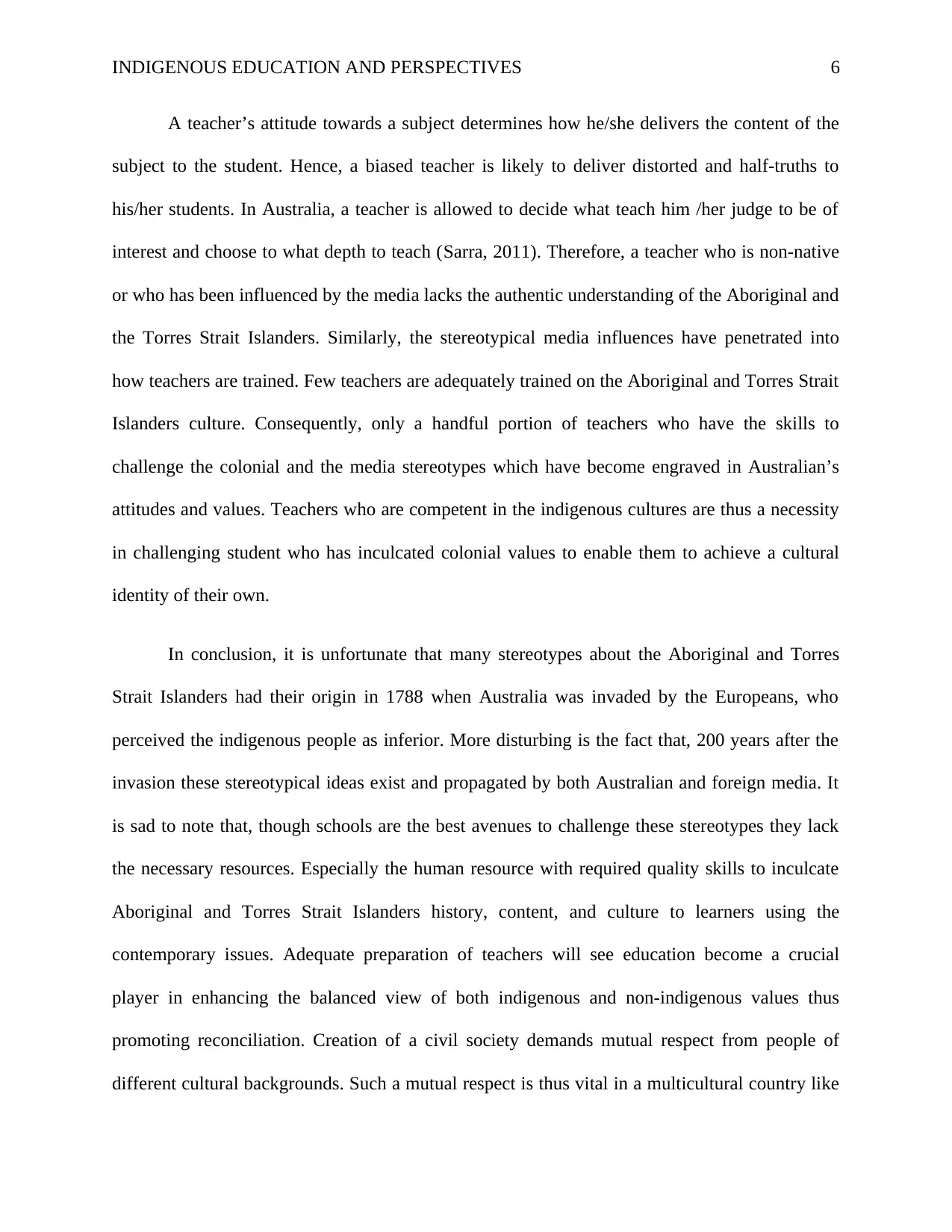
INDIGENOUS EDUCATION AND PERSPECTIVES 6
A teacher’s attitude towards a subject determines how he/she delivers the content of the
subject to the student. Hence, a biased teacher is likely to deliver distorted and half-truths to
his/her students. In Australia, a teacher is allowed to decide what teach him /her judge to be of
interest and choose to what depth to teach (Sarra, 2011). Therefore, a teacher who is non-native
or who has been influenced by the media lacks the authentic understanding of the Aboriginal and
the Torres Strait Islanders. Similarly, the stereotypical media influences have penetrated into
how teachers are trained. Few teachers are adequately trained on the Aboriginal and Torres Strait
Islanders culture. Consequently, only a handful portion of teachers who have the skills to
challenge the colonial and the media stereotypes which have become engraved in Australian’s
attitudes and values. Teachers who are competent in the indigenous cultures are thus a necessity
in challenging student who has inculcated colonial values to enable them to achieve a cultural
identity of their own.
In conclusion, it is unfortunate that many stereotypes about the Aboriginal and Torres
Strait Islanders had their origin in 1788 when Australia was invaded by the Europeans, who
perceived the indigenous people as inferior. More disturbing is the fact that, 200 years after the
invasion these stereotypical ideas exist and propagated by both Australian and foreign media. It
is sad to note that, though schools are the best avenues to challenge these stereotypes they lack
the necessary resources. Especially the human resource with required quality skills to inculcate
Aboriginal and Torres Strait Islanders history, content, and culture to learners using the
contemporary issues. Adequate preparation of teachers will see education become a crucial
player in enhancing the balanced view of both indigenous and non-indigenous values thus
promoting reconciliation. Creation of a civil society demands mutual respect from people of
different cultural backgrounds. Such a mutual respect is thus vital in a multicultural country like
A teacher’s attitude towards a subject determines how he/she delivers the content of the
subject to the student. Hence, a biased teacher is likely to deliver distorted and half-truths to
his/her students. In Australia, a teacher is allowed to decide what teach him /her judge to be of
interest and choose to what depth to teach (Sarra, 2011). Therefore, a teacher who is non-native
or who has been influenced by the media lacks the authentic understanding of the Aboriginal and
the Torres Strait Islanders. Similarly, the stereotypical media influences have penetrated into
how teachers are trained. Few teachers are adequately trained on the Aboriginal and Torres Strait
Islanders culture. Consequently, only a handful portion of teachers who have the skills to
challenge the colonial and the media stereotypes which have become engraved in Australian’s
attitudes and values. Teachers who are competent in the indigenous cultures are thus a necessity
in challenging student who has inculcated colonial values to enable them to achieve a cultural
identity of their own.
In conclusion, it is unfortunate that many stereotypes about the Aboriginal and Torres
Strait Islanders had their origin in 1788 when Australia was invaded by the Europeans, who
perceived the indigenous people as inferior. More disturbing is the fact that, 200 years after the
invasion these stereotypical ideas exist and propagated by both Australian and foreign media. It
is sad to note that, though schools are the best avenues to challenge these stereotypes they lack
the necessary resources. Especially the human resource with required quality skills to inculcate
Aboriginal and Torres Strait Islanders history, content, and culture to learners using the
contemporary issues. Adequate preparation of teachers will see education become a crucial
player in enhancing the balanced view of both indigenous and non-indigenous values thus
promoting reconciliation. Creation of a civil society demands mutual respect from people of
different cultural backgrounds. Such a mutual respect is thus vital in a multicultural country like
⊘ This is a preview!⊘
Do you want full access?
Subscribe today to unlock all pages.

Trusted by 1+ million students worldwide
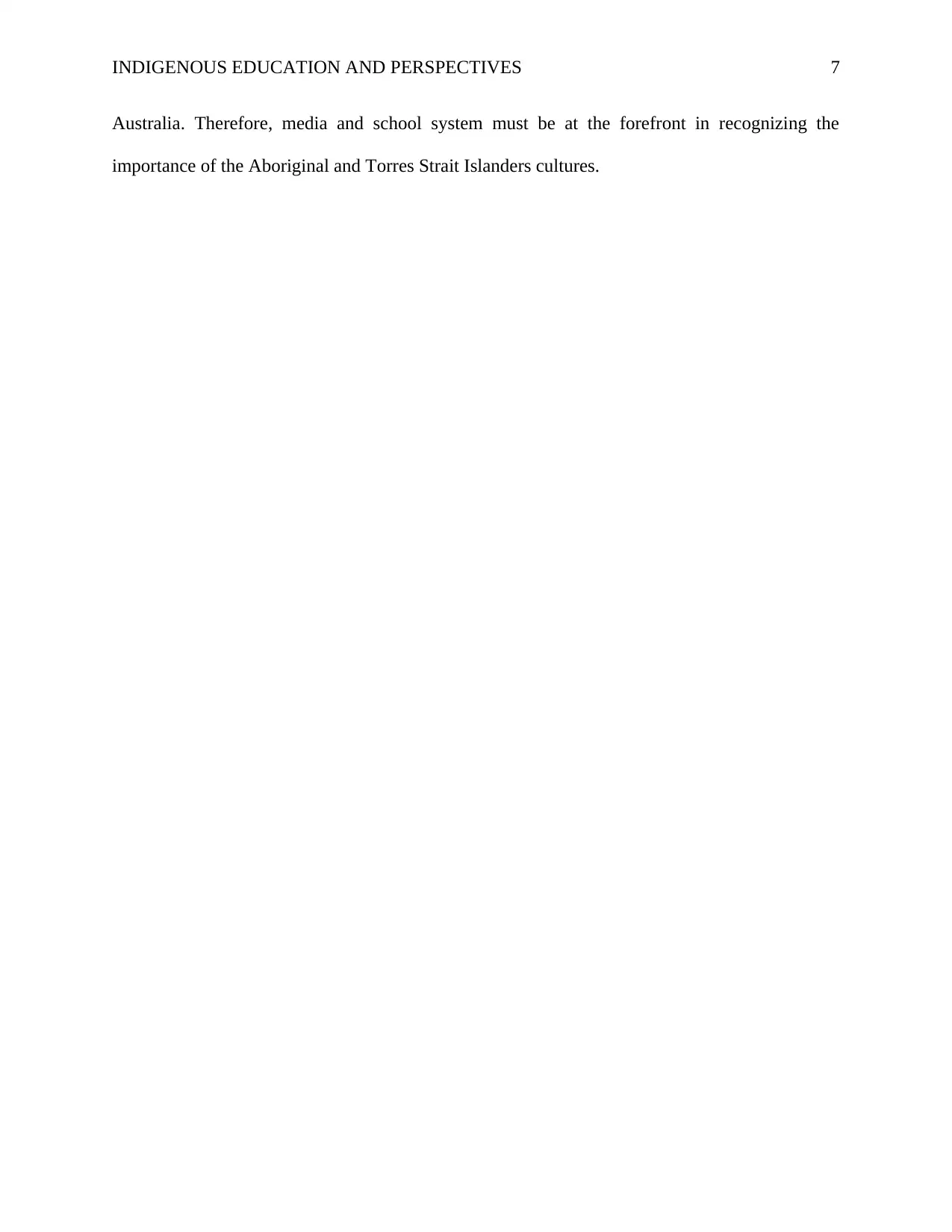
INDIGENOUS EDUCATION AND PERSPECTIVES 7
Australia. Therefore, media and school system must be at the forefront in recognizing the
importance of the Aboriginal and Torres Strait Islanders cultures.
Australia. Therefore, media and school system must be at the forefront in recognizing the
importance of the Aboriginal and Torres Strait Islanders cultures.
Paraphrase This Document
Need a fresh take? Get an instant paraphrase of this document with our AI Paraphraser
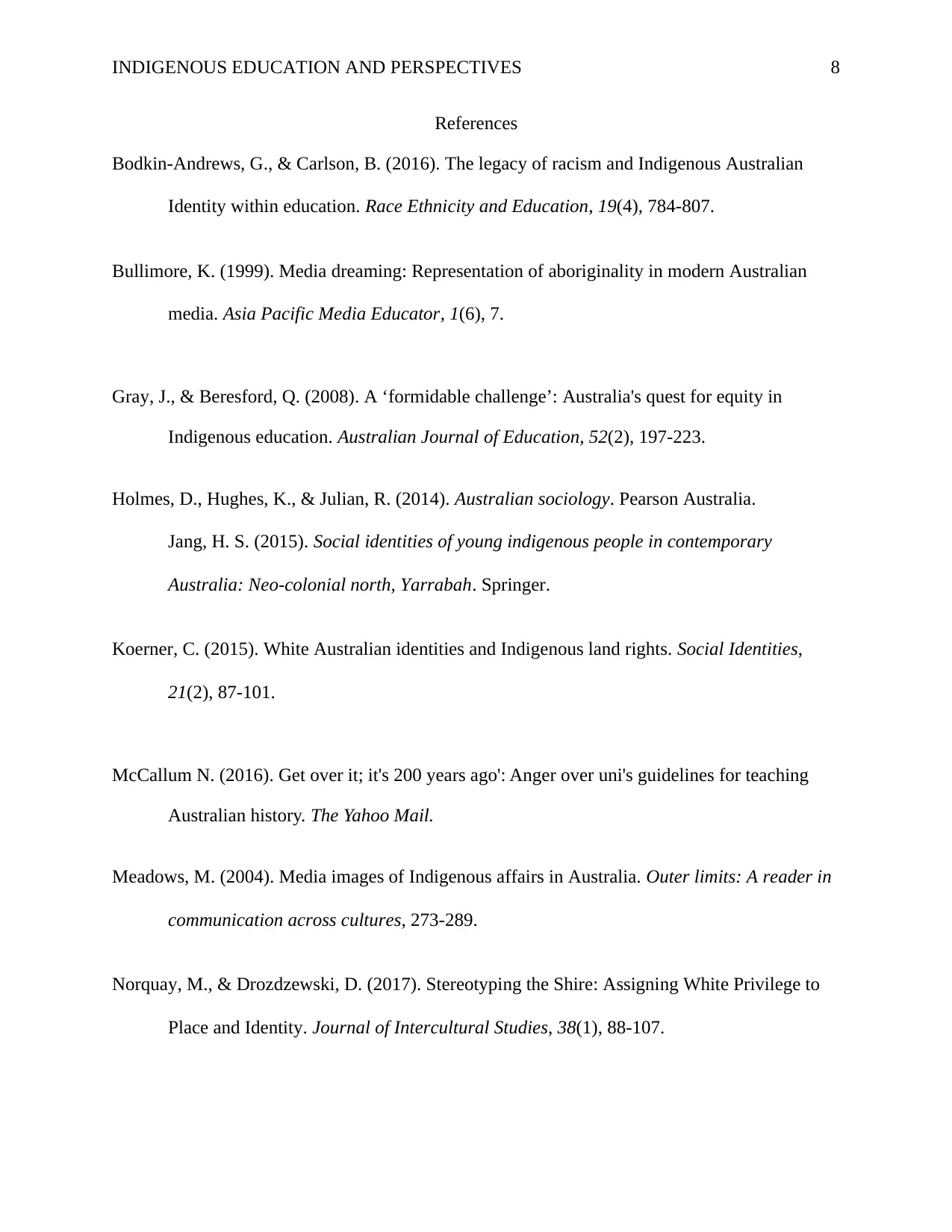
INDIGENOUS EDUCATION AND PERSPECTIVES 8
References
Bodkin-Andrews, G., & Carlson, B. (2016). The legacy of racism and Indigenous Australian
Identity within education. Race Ethnicity and Education, 19(4), 784-807.
Bullimore, K. (1999). Media dreaming: Representation of aboriginality in modern Australian
media. Asia Pacific Media Educator, 1(6), 7.
Gray, J., & Beresford, Q. (2008). A ‘formidable challenge’: Australia's quest for equity in
Indigenous education. Australian Journal of Education, 52(2), 197-223.
Holmes, D., Hughes, K., & Julian, R. (2014). Australian sociology. Pearson Australia.
Jang, H. S. (2015). Social identities of young indigenous people in contemporary
Australia: Neo-colonial north, Yarrabah. Springer.
Koerner, C. (2015). White Australian identities and Indigenous land rights. Social Identities,
21(2), 87-101.
McCallum N. (2016). Get over it; it's 200 years ago': Anger over uni's guidelines for teaching
Australian history. The Yahoo Mail.
Meadows, M. (2004). Media images of Indigenous affairs in Australia. Outer limits: A reader in
communication across cultures, 273-289.
Norquay, M., & Drozdzewski, D. (2017). Stereotyping the Shire: Assigning White Privilege to
Place and Identity. Journal of Intercultural Studies, 38(1), 88-107.
References
Bodkin-Andrews, G., & Carlson, B. (2016). The legacy of racism and Indigenous Australian
Identity within education. Race Ethnicity and Education, 19(4), 784-807.
Bullimore, K. (1999). Media dreaming: Representation of aboriginality in modern Australian
media. Asia Pacific Media Educator, 1(6), 7.
Gray, J., & Beresford, Q. (2008). A ‘formidable challenge’: Australia's quest for equity in
Indigenous education. Australian Journal of Education, 52(2), 197-223.
Holmes, D., Hughes, K., & Julian, R. (2014). Australian sociology. Pearson Australia.
Jang, H. S. (2015). Social identities of young indigenous people in contemporary
Australia: Neo-colonial north, Yarrabah. Springer.
Koerner, C. (2015). White Australian identities and Indigenous land rights. Social Identities,
21(2), 87-101.
McCallum N. (2016). Get over it; it's 200 years ago': Anger over uni's guidelines for teaching
Australian history. The Yahoo Mail.
Meadows, M. (2004). Media images of Indigenous affairs in Australia. Outer limits: A reader in
communication across cultures, 273-289.
Norquay, M., & Drozdzewski, D. (2017). Stereotyping the Shire: Assigning White Privilege to
Place and Identity. Journal of Intercultural Studies, 38(1), 88-107.
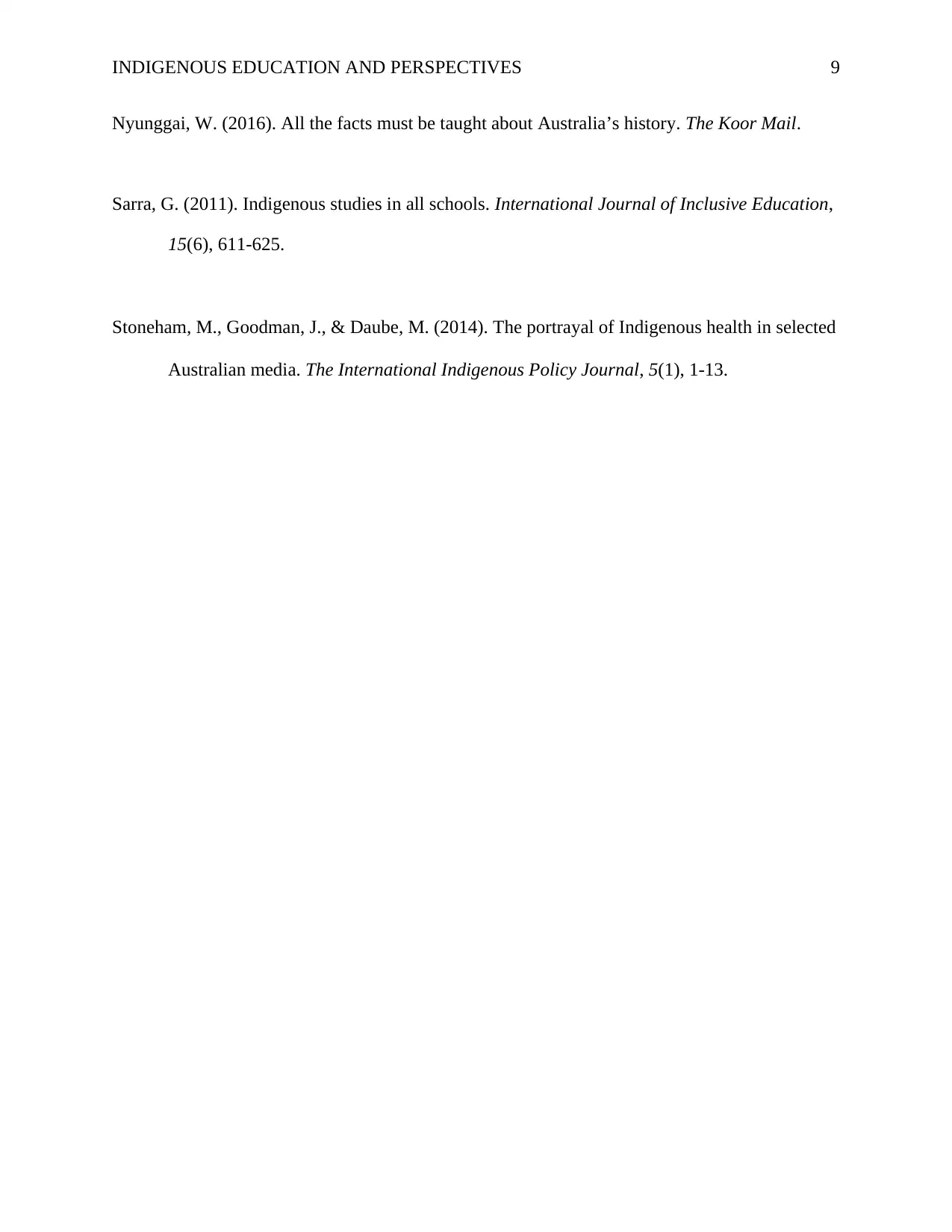
INDIGENOUS EDUCATION AND PERSPECTIVES 9
Nyunggai, W. (2016). All the facts must be taught about Australia’s history. The Koor Mail.
Sarra, G. (2011). Indigenous studies in all schools. International Journal of Inclusive Education,
15(6), 611-625.
Stoneham, M., Goodman, J., & Daube, M. (2014). The portrayal of Indigenous health in selected
Australian media. The International Indigenous Policy Journal, 5(1), 1-13.
Nyunggai, W. (2016). All the facts must be taught about Australia’s history. The Koor Mail.
Sarra, G. (2011). Indigenous studies in all schools. International Journal of Inclusive Education,
15(6), 611-625.
Stoneham, M., Goodman, J., & Daube, M. (2014). The portrayal of Indigenous health in selected
Australian media. The International Indigenous Policy Journal, 5(1), 1-13.
⊘ This is a preview!⊘
Do you want full access?
Subscribe today to unlock all pages.

Trusted by 1+ million students worldwide
1 out of 9
Related Documents
Your All-in-One AI-Powered Toolkit for Academic Success.
+13062052269
info@desklib.com
Available 24*7 on WhatsApp / Email
![[object Object]](/_next/static/media/star-bottom.7253800d.svg)
Unlock your academic potential
Copyright © 2020–2025 A2Z Services. All Rights Reserved. Developed and managed by ZUCOL.





